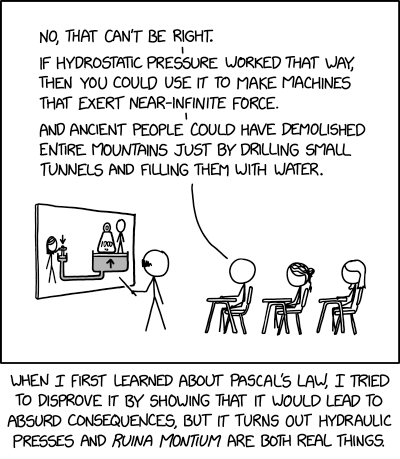At the left, a teacher is holding a pointer, pointing at a picture on the screen.]
[The picture shows a hydraulic lift, with a small fluid vessel on the left connected to a tube at the bottom, which connects to a large vessel on the right. On top of the large vessel is a weight labeled 1000 and a Cueball. The fluid in the large vessel is labeled with an upward arrow. Megan's hand is over the small vessel, with a downward arrow indicating that she's pressing on it.]
[Cueball, Hairbun, and Blondie are sitting at school desks going right to left.]
Cueball: No, that can't be right.
Cueball: If hydrostatic pressure worked that way, then you could use it to make machines that exert near-infinite force.
Cueball: And ancient people could have demolished entire mountains just by drilling small tunnels and filling them with water.
[Caption below comic:]
When I first learned about Pascal's law, I tried to disprove it by showing that it would lead to absurd consequences, but it turns out hydraulic presses and ruina montium are both real things.

They certainly should've; it's just a consequence of how pressure is force divided by area.
Here's an analogy that might make it feel less weird: you know how you can reduce the force needed to lift a heavy weight by using a lever and making the lever arm longer? This is the same kinda deal, except that instead of varying the length of the lever arm you're varying the diameter of the hydraulic pistons.
You don't get it for free, of course: just like how you have to push the long end of the lever a longer distance to lift the weight a shorter distance, in a hydraulic system you have to press the plunger further down the small-diameter piston to move the plunger in the large-diameter piston up a smaller amount.
(I thought of mentioning pulley systems as an analogy too, but of these three varieties of gaining mechanical advantage I find pulley systems to be the most confusing, LOL.)
Archimedes over here with his bigass lever
No, you're right, pulleys are mechanical witchcraft, I tell you!
Another example: gears. You have a small wheel moving a large wheel trading speed for torque (or vice versa).